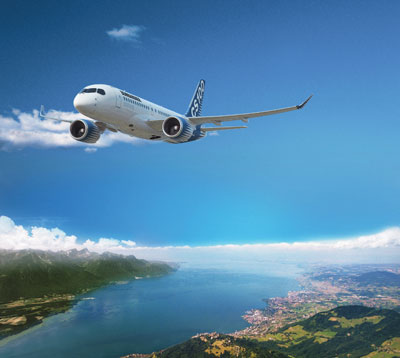
News
At The Gate: The ABCs of the CSeries
It’s one of the most aggressive new aircraft development programs in its history and Montreal’s Bombardier Aerospace is looking forward to seeing the fruits of its labour later this year.
October 31, 2012 By Brian Dunn
It’s one of the most aggressive new aircraft development programs in its history and Montreal’s Bombardier Aerospace is looking forward to seeing the fruits of its labour later this year.
 |
|
| That delay is a nanosecond compared to the multi-year delays of Boeing’s 787 Dreamliner and the Airbus A380. Photo: Bombardier |
If everything goes according to plan, first flight of Bombardier’s CSeries CS100 110-seat single-aisle aircraft will have been completed in December and will enter into service by the end of 2013. The 130-seat CS300 aircraft should enter service a year after that. But as the target date approaches, speculation abounds that first flight will only occur in early 2013 and that Bombardier is trying to shift the focus away from first flight and emphasize the service entry date at the end of next year.
“Our target is to fly in December. But I always said in these types of programs, given that I’ve done a few, three to five months would be considered on schedule,” Bombardier CEO Pierre Beaudoin said. “That delay is a nanosecond compared to the multi-year delays of Boeing’s 787 Dreamliner and the Airbus A380.”
Bombardier acknowledges that some CSeries suppliers have had challenges delivering components on time and that they are working with the suppliers to try to solve the problem. But some fuselage components being built in China have been transferred to Bombardier’s Montreal plant and other western suppliers, according to industry reports.
In August, the company started conducting virtual flights on “Aircraft O,” the on-the-ground Integrated Systems Test and Certification Rig at its Mirabel plant north of Montreal. The avionics, electrical, flight control, fly-by-wire, hydraulic, landing gear and wiring systems are now all commissioned and systems integration and communication have been successfully demonstrated. The development of the aircraft will now enter the intense ground-testing phase that will build the necessary maturity for all systems and drive towards the flight test program.
The successful commissioning of all the systems on “Aircraft 0” was supported by several key aircraft partners and suppliers, including CAE, Goodrich Actuation Systems, Hamilton Sundstrand, Honeywell, Liebherr-Aerospace, Parker Hannifin, Pratt & Whitney, Rockwell Collins and Fokker Elmo, along with other structural and system suppliers that delivered all the required components.
Other CSeries ground-test rigs located at Mirabel include CAE’s Engineering Flight Simulator and the Interior and Environmental Control Systems. Rockwell Collins has already commissioned the avionics Systems Integration Test Stand and Parker Hannifin has commissioned the Flight Controls Integration lab at its own facilities.
Bombardier has a lot riding on the new aircraft, which represents an investment of about $3.4 billion. Not only does it enhance its existing fleet of business and commercial offerings, but it will also provide close to 2,500 direct jobs in Quebec and hundreds more across Canada. Any delays will not only increase development costs, but will result in penalties from customers. A case in point is Boeing’s 787 Dreamliner, which was three years behind schedule due to engineering problems and delivery delays from suppliers. Delays continued even after the Dreamliner went into production, resulting in costly payments to customers. The Airbus A380 had similar problems.
The CSeries is also moving in on the traditional turf of Boeing and Airbus and must follow through on its promise of reducing operating costs by 20 per cent compared to existing aircraft to garner new orders. The two leading aircraft manufacturers will not give up their turf without a fight. Airbus already has plans to equip its A319 model with the same Pratt & Whitney PurePower PW1000G turbofan engines that will power the CSeries.
Bombardier’s 20-year forecast predicts the construction of 6,900 aircraft in the 100- to 149-seat range of which it expects to win at least half those orders. “Since the launch of the CSeries program in 2008, we’ve received 66 per cent of the orders in the 100- to 149-seat category,” according to Mike Arcamone, president of Bombardier Commercial Aircraft. But orders aren’t exactly flying through the door. As of the end of June, Bombardier has received only 138 firm orders for the CSeries and no options.
On a more positive note, Bombardier said WestJet’s firm order for 20 Q400 NexGen turboprops has a list value of $683 million.
In addition, Bombardier increased its lead over its closest rival in the business jet market, selling $2.37 billion of aircraft in the second quarter of this year, a 10-per-cent increase from a year ago, according to the General Aviation Manufacturers Association. By comparison, Gulfstream sold $1.84 billion worth of business aircraft, a 12-per-cent drop. Number 3 player Dassault Falcon saw sales almost double during the same period to $1.53 billion from $846.5 million.
In short, it promises to be a very important year for Canada’s premier aircraft manufacturer – one that could reinforce its position on the world stage.
Brian Dunn is a Wings writer and columnist.